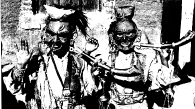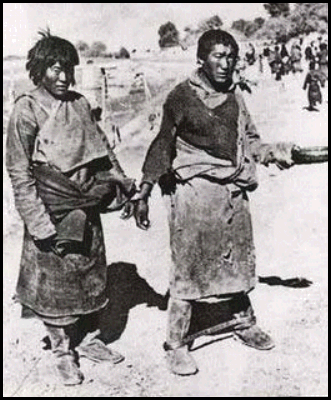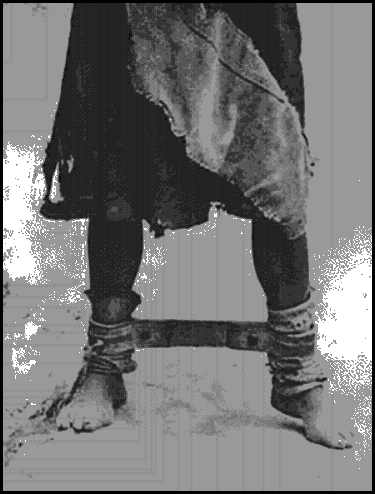Lost Tibet
(Snow Lion)
 "Everyone," said Diderot, "is cursed with their history." Germany will never escape the photographs from 1944 --- rooms filled with hair, the mountain of spectacles, the sad shoes. Those --- along with the music of Bach, Martin Luther's 95 theses, and noisy, brawling oktoberfests --- are the heritage of that strange country.
"Everyone," said Diderot, "is cursed with their history." Germany will never escape the photographs from 1944 --- rooms filled with hair, the mountain of spectacles, the sad shoes. Those --- along with the music of Bach, Martin Luther's 95 theses, and noisy, brawling oktoberfests --- are the heritage of that strange country.The Roman Catholic Church --- despite being founded by Jews --- will never erase its history of willful torture and murder of any and all dissidents during the Inquisition, and ignoring the plight of European Jews before and during WWII. And many in the U.S. remember the proscribed list of books and motion pictures compiled by the church during the first half of this century --- a list that included "Forever Amber," "The Jewels of Rome," "The Moon is Blue," and all of Henry Miller's books.
Nor can we forget that for a century, the southern states of the United States used the whip, the shotgun and the hanging-rope as an adjunct to political control, and, in the process, gave us crude tyrants like Senator Theo. Bilbo, Gov. George Wallace, and the late Strom Thurmond. (Thurmond's early Senate speeches on civil rights are an enlightening revelation of the true heart of one who was referred to as the "Grand Old Man" of the Senate).
The French have an exquisite culture (Flaubert, Proust, Malraux, Chartres, Avignon, the glorious design of Paris) --- but they also have a lurid history as a colonial power, especially in their treatment of political activists in Algeria, French Indochina, and in Africa. They aren't alone: despite its reputation as a stolid and caring nation, it was the Swedes who gave permission in 1940 for the Nazis to cross their territory and invade Norway. Another product of superb Swedish engineering.
In 1914 --- Americans were told endlessly of "the rape" of "plucky little Belgium" --- oblivious to the fact that scarcely a decade before, King Leopold II had to be brought to task by the rest of the world (something new in the concert of nations) for his vicious brutalizing of the denizens of the Belgian Congo. And the United States? How quickly we forget that it was standard foreign policy, implemented by the CIA, to "destabilize" (eg, destroy) democratically elected governments in Chile, Guatemala, and Iran, among other soverign nations.
And those behemoths of oligopoly? Who can forget the fate of strikers at River Rouge, the Ford Company plant in 1938 --- men beaten for merely trying to organize. General Motors, sent private detectives around to follow Ralph Nader, as he was building the case for Unsafe at Any Speed ("if you can't attack his facts, attack his morals.")
Closer to home for us closet liberals, we recall that the New York Times consistently ignored the ruinous collectivization of the kulaks in Stalinist Russia during the 30's (resulting in starvation and death for perhaps 5,000,000 people in the Ukraine). And our beloved Los Angeles Times regularly praised Sen. Joe McCarthy as he competed with himself to find even more subversives in the state department. The Washington Post? Up to thirty-five years ago, they published, regularly, in agate type, for all to see, complete lists of people arrested for attending gatherings of suspected homosexuals. In those days, suspicion was tantamount to conviction, especially for the heinous crime of being gay; especially in Washington, D. C.
There is always something, isn't there? When Jack, the cynical, worldly narrator of All The King's Men demurs, the governor --- the Boss --- tells him,
"Man is conceived in sin and born in corruption and he passeth from the stink of the didie to the stench of the shroud. There is always something..."
Always something. Even in the history of the man who, in so many eyes, is our own twentieth century St. Christopher --- the saintly Dalai Lama.

All those who believe in such will get a bit of a shock from A Portrait of Lost Tibet. The government of Tibet, before it ceased to exist in 1959, was a theocracy. Theocracies may be just --- at least to their own god-view --- but they are hardly ever kindly. The two million people of Tibet, before being subjected to exploitation and legal violence at the hands of the Chinese, were subject to the same conditions by their own ruler's captious ways.
A Portrait of Lost Tibet is an honest portrait, both photographically and textually. There are included here over a hundred photographs of the country from the years 1942 - 1943. The pictures were taken by Brooke Dolan and Ilya Tolstoy (grandson of Count Leo), who had been hired by the Office of Strategic Services --- predecessor of the CIA --- to traverse the country, recording its people and terrain. It was hoped that the dangerous flights being made by the United States over the Himalayas, with the war supplies being sent from India to China, could be superseded by trekking of the materials over the mountains with stolid Tibetan bearers. (The flights, going over what was called "The Hump," were subject to life-threatening winds, storms, and a 20,000-foot altitude. Roosevelt had looked at a map and decided that hauling supplies over the trails of Tibet would be safer. "Obviously," says the author, FDR "was not looking at a topographical map.")
Although Tolstoy and Dolan were not professional photographers, the pictures here are grand. Perhaps it was the country, the people, the mystery of it all being opened, at last, to the lens. Tolstoy was an explorer (central Asia, Africa); Dolan had already visited the Kham and Amdo regions of eastern Tibet, and spoke several Tibetan dialects. The trip lasted from September of 1942 to the early summer of 1943. Although the exploration was technically a failure, it was in another way a success --- a whole culture has been preserved for us, a distinct way of life, with extensive portraits of architecture, markets, individuals, religious and political leaders, all from a lost time and place.
Since Tibet was ostensibly an ally (through its intense fear of the Chinese), and since we wanted their cooperation --- there was no reason for Tolstoy and Dolan to propagandize, to paint an unnecessarily dark (or unnecessarily light) picture of this forbidden land.
Indeed, in their writings, their love for Tibet stands out --- which lends even greater veracity to their words:
Murder and lesser crimes are very common in Chang, robbery less rife than in Lhasa ... The commonest punishment is a lashing: 100 lashes is not considered severe for a misdemeanor. For thievery, armed brigandage, or murder, the penalty is loss of one or both hands or legs, which are cut above the knee. To seal the arteries the stumps are at once plunged into boiling oil, but the Chanchi [a government official] complains that many culprits die after amputation of the legs. Such death compounds a sin which may rebound upon the justice and his minions. "Many prisoners," remarked the Changchi, "prefer lashing to amputation but after severe lashing delivered on the buttocks and just below, the culprit is seldom able to walk again as the muscles and tendons are destroyed. As many as 1,000 lashes are administered and death may ensue."
The author notes without comment that "the harshness of the ancient laws sometimes stood out in stark contrast to tenets of the religion."
A Portrait is divided into five sections:
- "Environment,"
- "Portraits of the People of Tibet,"
- "The Way of Life,"
- "The Festivals," and
- "Religion."
A Portrait is alive with fascinating details painted by two obviously curious, scientifically minded, observant explorers. Nomads considered "bile from a wild bear ... a good tonic. Goat fat was healing for "chronic sores and abrasions." Fires were difficult to keep going in the oxygen-thin air of the highlands, and bellows made of the whole skin of a goat were used. Nomads had "long bangs that almost covered their eyes, English sheepdog fashion." This, they discovered, was an age-old safeguard against glare and snow blindness.

Then there are the many Tibetan festivals: One of the happiest "...was a kite-flying festival. When a kite mounted especially high, the string sometimes would be cut. In Tibetan belief ... the kite represented a prayer mounting to heaven."
For the Tibetan poor, the staple diet was barley, yogurt, cheese, and meat. Visitors were offered yak-buttered tea and tsampa --- roasted barley mixed with tea, "forming a paste that was then rolled into balls and eaten with the fingers." The upper classes would eat shark fins, mutton-ball soup, sea slugs, cold lamb's tongue, sugarplums, spaghetti made of pea flour, and, of all things, canned pears, pineapples, and peaches.
When Tolstoy and Dolan left Tibet in 1943, they had asked that the court officials send along some stamps, because FDR was a stamp collector and would appreciate such a rare gift from such a rare country. "The Tibetans turned down the request, however," says the author. "They felt that any gift made of paper was not suitable for the head of a great country."
This, then, is the culture from which the Dalai Lama sprang --- indeed, the culture that he and his elders ran. The punishments, those dreadful lashings and amputations, were carried out under his ægis. It was a harsh, a cruel regime.
But we should always ask if the master, himself martyred by the Chinese, has learned a new way, a way in keeping with the humility and love prescribed by his religion? Have the years spent away from his stern theocracy tempered him, made him more compassionate, especially towards the dispossessed?
Perhaps so --- but in one of his latest books, Beyond Dogma, the Dalai Lama approvingly quotes the guru Ashvaghosha on the question of sexual behaviour. Misconduct is determined, he says, by "inappropriate partner, organ, time, or place."
"Inappropriate partners include men for men, women for women, women who are menstruating or in the early stages of nursing, men or women who are married to another, monks or nuns, and prostitutes 'paid for by a third party and not oneself.'" (These quotes come to us from Tricycle, the Buddhist magazine, one that would hardly be expected to be critical of the Dalai Lama)
Steve Peskind --- of the San Franciso AIDS Project (again, in quote from the magazine) --- opined to the Dalai Lama that these strictures would seem to "support the climate of international psychological, spiritual, physical, social, and political discrimination, violence and human rights violations against gay people." He went on to say that His holiness "did not clarify how sex as an expression of emotional intimacy...impedes the path to full awakening, freedom, and peace of heart."
At the end of the meeting, one José Cabezón said, "It is wonderful to see a religious thinker of the caliber of the Dalai Lama grappling with the issues of sexual ethics...in such an open, empathetic, and rigorous fashion." He may have been seen to "grapple" --- but what a pity that they had not chosen to let him grapple with an even harder question, ones concerning the treatment of his own countrymen, in an earlier era.